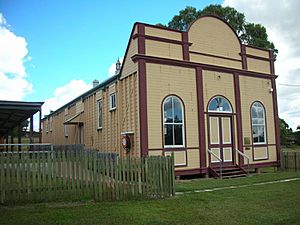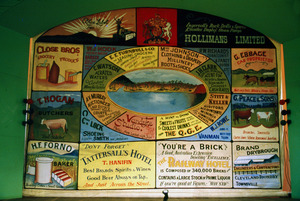Ravenswood School of Arts facts for kids
Quick facts for kids Ravenswood School of Arts |
|
|---|---|

Ravenswood School of Arts, 2009
|
|
| Location | Macrossan Street, Ravenswood, Charters Towers Region, Queensland, Australia |
| Design period | 1870s—1890s (late 19th century) |
| Built | 1884 |
| Architectural style(s) | Classicism |
| Official name: Ravenswood School of Arts | |
| Type | state heritage (built) |
| Designated | 21 October 1992 |
| Reference no. | 600453 |
| Significant period | 1880s–1920s (historical) |
| Significant components | school of arts |
| Lua error in Module:Location_map at line 420: attempt to index field 'wikibase' (a nil value). | |
The Ravenswood School of Arts is a special old building in Ravenswood, Australia. It was built in 1884 and is listed on the Queensland Heritage Register. This means it's an important historical place that needs to be protected.
The building served as a "School of Arts," which was like a community center and library in the past. It was a place where people could learn, read, and enjoy social events. For many years, it was the main spot for plays, movies, and gatherings in Ravenswood.
Contents
A Look Back: The History of Ravenswood
Ravenswood was once a very important gold mining town in North Queensland. Gold was discovered there in 1867. Many people moved to the area hoping to find their fortune. The town grew quickly because of the gold.
Gold Rush and Town Growth
At first, miners found gold close to the surface. Soon, small settlements popped up. Ravenswood was officially named a town in 1871. However, the gold found deeper down was harder to get out. This meant special machines and more money were needed.
Many miners left for other goldfields, like Charters Towers, which became bigger. But Ravenswood still did well. It had a steady, though smaller, amount of gold. Silver was also found nearby in 1878. The town became a local business hub. By 1874, Ravenswood had important buildings like a courthouse, police station, and a hospital.
What Was a School of Arts?
The first School of Arts in Ravenswood started in 1872. It was a small building that offered a library and a place for people to meet. In 1875, a separate library building was added next to it.
Schools of Arts were popular in Britain and Australia in the 1800s. They were created to help people learn and grow. They offered lectures, discussions, and, most importantly, lending libraries. Before public libraries, these places were vital for people to access books and learn new things. The first one in Queensland was in Brisbane in 1849.
The New School of Arts Building
In 1884, the railway arrived in Ravenswood, which helped the town's economy. New public buildings were constructed, including the current School of Arts hall. This new hall was built next to the old library. It was much larger and could host plays, concerts, and other fun events. It became the main place for entertainment and social gatherings in town.
An amateur drama group put on plays every year. School concerts and St Patrick's Day celebrations were also big events. Around 1899, a new company called New Ravenswood Company helped the town's gold mining boom again. This was Ravenswood's most successful time.
Decline and Revival
After 1908, it became harder and more expensive to find gold. After World War I, the gold mining slowed down a lot. In the 1920s, many people and even buildings left Ravenswood. Some timber buildings were moved to other towns.
The town's population dropped to just 70 people by the 1960s. However, tourists started to become interested in Ravenswood's history. Efforts began to protect its old buildings. In the 1980s, the whole town was listed by the Australian Heritage Commission.
In 1987, a new mining company opened an open-cut gold mine. This brought new life to Ravenswood. In 1989, a big storm called Cyclone Aivu damaged the School of Arts hall. The old library building next to it completely fell down and was later removed.
The community worked hard to repair the hall. The front of the building was rebuilt to look like it did originally. In 1990, the local council and the mining company helped pay for big renovations. The hall officially reopened in 1991. Since then, it has once again become a central place for community events and celebrations, like the "Back To Ravenswood Weekend" held every year.
Building Features
The School of Arts building is on Macrossan Street, the main street of Ravenswood. It's near the town's business area and close to the Imperial Hotel. The town itself is surrounded by old mining areas with ruins and piles of rock.
The School of Arts is a single-story building made of timber. It sits on low concrete supports. The roof is shaped like a triangle (gabled) and covered with corrugated iron. The front of the building has a neat, balanced look with columns and arched windows.
Inside, there's a large open space and a stage. The stage curtain is very special. It has old advertisements painted on it for local businesses from around the early 1900s. This shows how important the building was to the community.
Why It's Important
The Ravenswood School of Arts is listed on the Queensland Heritage Register because it's a significant part of Queensland's history.
- Community Hub: It shows how Schools of Arts helped towns grow. They were important places for learning, meetings, and social events.
- Classic Design: The building is a good example of a School of Arts hall. It has a classic design and was built for public events.
- Town Landmark: It's a key part of the Ravenswood townscape. It stands with other important public and business buildings.
- Community Connection: The building, especially its painted stage curtain, shows its strong link to the Ravenswood community. It has always been a vital part of the town's social life.


